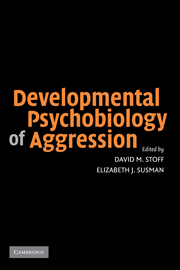Book contents
- Frontmatter
- Contents
- Foreword
- INTRODUCTION
- PART I PLASTICITY
- 2 The Interaction of Biological and Social Measures in the Explanation of Antisocial and Violent Behavior
- 3 Social Deprivation, Social–Emotional Behavior, and the Plasticity of Dopamine Function
- 4 Animal Studies on Inappropriate Aggressive Behavior Following Stress and Alcohol Exposure in Adolescence
- 5 Links Between Girls' Puberty and Externalizing and Internalizing Behaviors: Moving from Demonstrating Effects to Identifying Pathways
- PART II BIDIRECTIONALITY
- PART III GENE–ENVIRONMENT INTERACTIONS
- CONCLUSION
- Author Index
- Subject Index
- References
2 - The Interaction of Biological and Social Measures in the Explanation of Antisocial and Violent Behavior
Published online by Cambridge University Press: 14 July 2009
- Frontmatter
- Contents
- Foreword
- INTRODUCTION
- PART I PLASTICITY
- 2 The Interaction of Biological and Social Measures in the Explanation of Antisocial and Violent Behavior
- 3 Social Deprivation, Social–Emotional Behavior, and the Plasticity of Dopamine Function
- 4 Animal Studies on Inappropriate Aggressive Behavior Following Stress and Alcohol Exposure in Adolescence
- 5 Links Between Girls' Puberty and Externalizing and Internalizing Behaviors: Moving from Demonstrating Effects to Identifying Pathways
- PART II BIDIRECTIONALITY
- PART III GENE–ENVIRONMENT INTERACTIONS
- CONCLUSION
- Author Index
- Subject Index
- References
Summary
INTRODUCTION
One of the important contributions to the understanding of antisocial and aggressive behavior has come from research that spanned the areas of animal research (Cairns, Hood, & Midlam, 1985), genetic processes (Cairns, McGuire, & Gariepy, 1993), attachment (Cairns, 1966), social interactions (Cairns & Valsiner, 1984), and developmental epistemology (Cairns, 1990). Unlike much other research, this integrative vision of science was not blinded by the interdisciplinary rivalries that have both pervaded and impeded the study of antisocial behavior. Instead, by viewing genetic, biological, psychological, and social influences as equal partners in the explanation of antisocial and aggressive behavior, more significant and lasting advances can be made in this field.
In this context, important progress has been made in delineating replicable psychosocial risk factors for antisocial and violent behavior (Farrington, 2000; Loeber & Farrington, 1998; McCord, 2001; Rutter, Giller, & Hagell, 1998). Within the past 15 years, important progress has also been made in uncovering biological risk factors that predispose to antisocial behavior (Lahey, McBurnett, Loeber, & Hart, 1995; Susman & Finkelstein, 2001). Despite this progress, we know surprisingly little about how these different sets of risk factors interact in predisposing to antisocial behavior. Furthermore, although passing heuristic and theoretical references are frequently made to such interactional influences, there are remarkably few investigators who are conducting serious empirical research on this interface in humans (Raine, Brennan, & Farrington, 1997).
- Type
- Chapter
- Information
- Developmental Psychobiology of Aggression , pp. 13 - 42Publisher: Cambridge University PressPrint publication year: 2005
References
- 16
- Cited by



